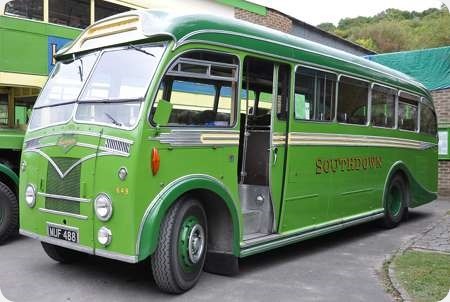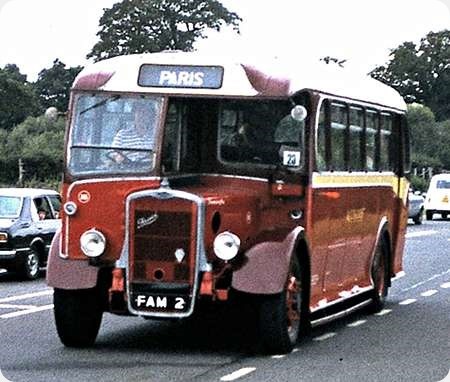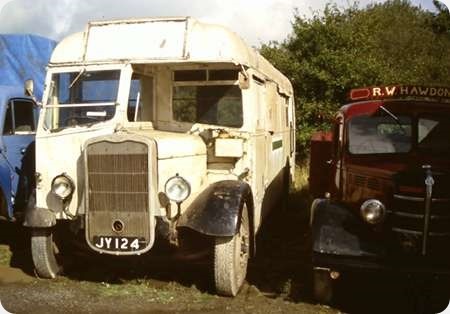Southdown – Beadle – Leyland – MUF 488 – 649
Southdown Motor Services Ltd
1953
Beadle – Leyland
Beadle FB31F
MUF 488 is one of those curious vehicles built by Beadles using Bedford or Leyland parts. The Leyland ones came from Tigers or Titans. In this case, the combination was delivered to Southdown in 1953, and has a FB31F body on TD5 running units. We see it outside the Southdown garage at Amberley on 13 September 2009.
Photograph and Copy contributed by Pete Davies
05/03/17 – 16:03
I suppose these days this would be called ‘recycling’. It is quite a nice looking coach although the front end lets it down a bit. Rather plain around the grille area and the joint between the upper windscreen sections and the destination display sits a bit uncomfortably.
Philip Halstead
06/03/17 – 07:08
If my information is correct, the NGT group had 18 of the type. They were all built on refurbished pre war AEC Regal chassis, and although mechanically an AEC down to the last nut and bolt., none of them carried AEC badges or logos. Northern had 10 FC35F versions DCN 83/92 – 1483/92; all similar to the example above, 1483 is currently undergoing restoration in the very capable hands of the NEBPT Ltd, who set themselves very high standards, I look forward to seeing the end result.
The other eight were for Wakefields Motors at Percy Main depot. Six were delivered in 1952, FT 7275/80 – 175/180, and were FC35F, the fronts differed to these, in that they had more bright trim, and an altogether softer look about them. A photo of 178 is posted elsewhere on this site. The other two FT 7791/2, 191/2 arrived in 1953, they were FC39F, as well as a larger seating capacity, they had a similar front to these which had a different destination layout incorporating a number section, to allow them to be used as D/P’s. All the P/M intake were different to those of NGT, in that they had twin cab doors and a full bulkhead separating the cab from the passenger saloon.
191/2 were sold to Garner Bridge of Weir, and 175/80 were exported to Yugoslavia of all places.
Ronnie Hoye
06/03/17 – 07:08
The running units for this coach came from pre-war Leyland Tiger TS8 FCD 368, which was delivered to Southdown in January 1939. The original Harrington B34R body, which had been temporarily converted to B30R perimeter seating (plus up to 30 standing) during the war, was rebuilt (not rebodied) by Portsmouth Aviation in August 1947. This body was removed and sold for scrap in February 1953, and the chassis was then cut to form front and rear running units for attachment to the integral Beadle body structure. The same construction principle was adopted some years later for the London Transport Routemaster. The Beadle body was offered in 30ft or 26ft lengths, and Southdown had examples of both. (Southdown also employed Beadle to fit full fronts of similar appearance to its Duple bodied PS1 coaches of 1947 to 1949 vintage.) Beadle Rebuilds (as the integral conversions became generally known) were introduced also at around the same time (early 1950s) by Maidstone and District and East Kent, again using Leyland running units.
Roger Cox
06/03/17 – 07:09
This vehicle has SOUTHDOWN in capital letters, which would make it a bus rather than a coach.
Chris Hebbron
06/03/17 – 17:12
Thanks for your thoughts, folks. The PSVC listing for this vehicle does not show whether it is TD or TS, but it does say B31F (not FB31F). Jenkinson says TD5 with FC35F. I note that his 1978 descriptions have been out of synch with other sources before! Chris H, yes, the general view is that it is a bus, but study the script on the front. I can understand why some consider it to be a coach. Now, where did we leave the discussion about bus, coach or dual-purpose?
Pete Davies
08/03/17 – 16:35
MUF 488 used the running gear from TS8 1468 (FCD368). It was delivered as a coach (888) but downgraded to bus work and renumbered 649 in 1958. Block lettering was usually, but not exclusively used on Buses. For example, the 15xx East Lancs Royal Tigers were delivered as DP’s with block lettering, but received ‘Mackenzie script’ when converted to OMO buses. The utility Guy open topers and Northern Counties DP Leopards also had ‘Mackenzie script’ and I have seen pictures of Beadle PD2/12’s similarly adorned. The front plaque with ‘Mackenzie script’ was a device used on many vehicles in place of the usual ornate Leyland marque badges. They were also used on ‘Queen Mary’s’. Hope this helps to clear up a few points noted previously.
Roy Nicholson
09/03/17 – 06:52
Thanks, Roy
Pete Davies
01/12/18 – 07:07
I recall this bus on omo operations with Southdown in the 50’s-60-s before sale to a Scout Group where it was painted blue. A friend of mine Ray Oliver from Chichester bought it and ran it for a time before selling it to whoever did the current repaint restoration. Alas we lost contact many years ago.
Keith Styles
03/12/18 – 09:26
I think the current owner has a couple of Southdowns and maybe this one will be out and about soon.
Roger Burdett
10/02/19 – 07:35
Re the Beadle re-bodied Southdown buses. Although they were mainly on the private hire/excursion work, they were used on a trial Service from Worthing to Steyning, I think numbered 66. The service ran from Worthing via North Lancing to the Sussex Pad, then along the narrow road to Bramber and Steyning. I don’t think it was a success.
Paul Kidger
Quick links to the - Comments Page - Contact Page - Home Page



